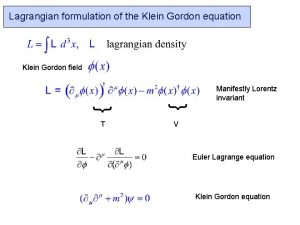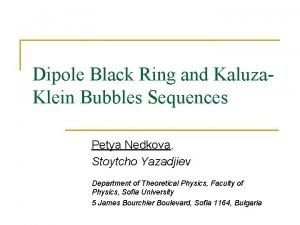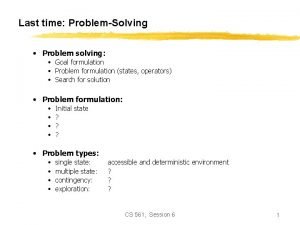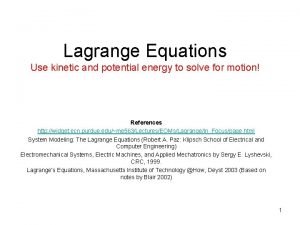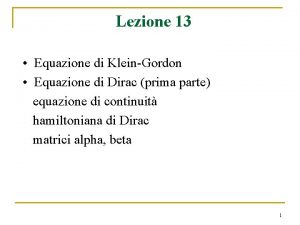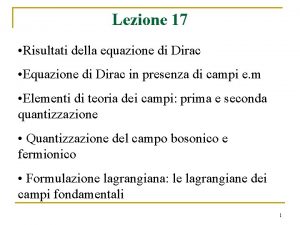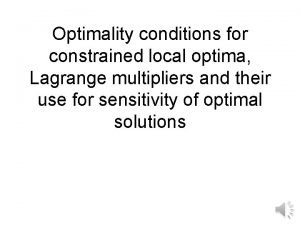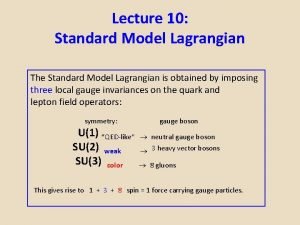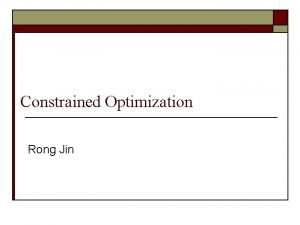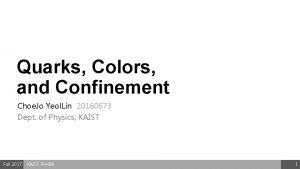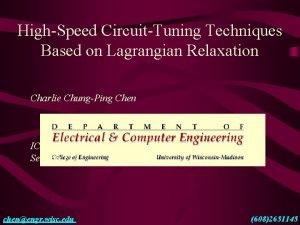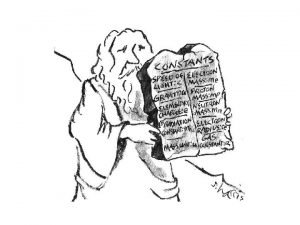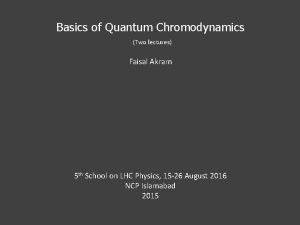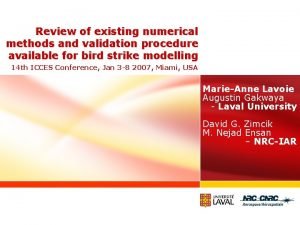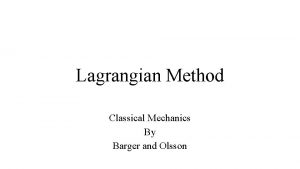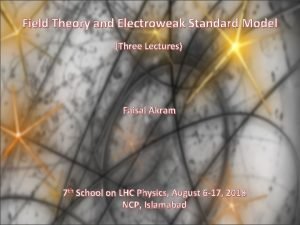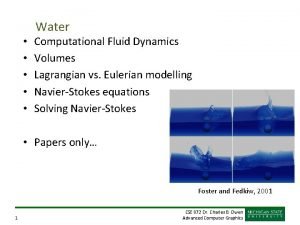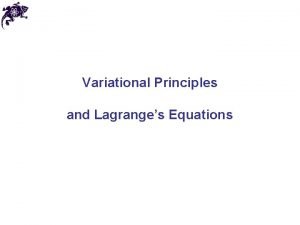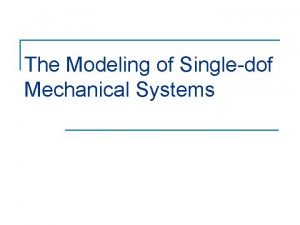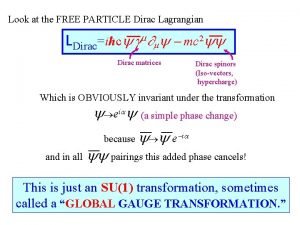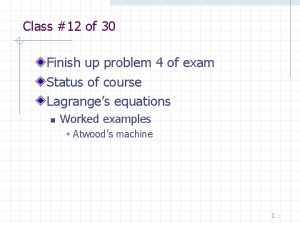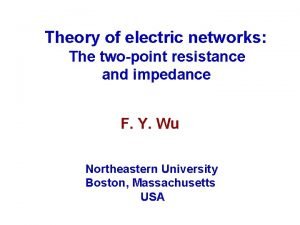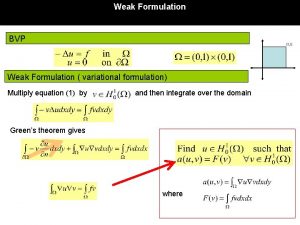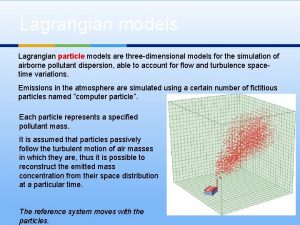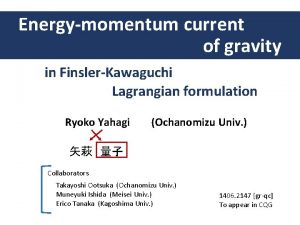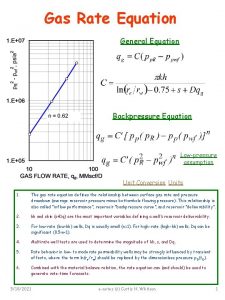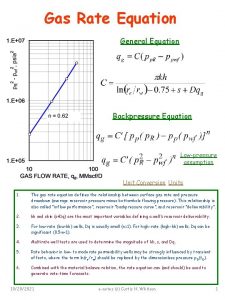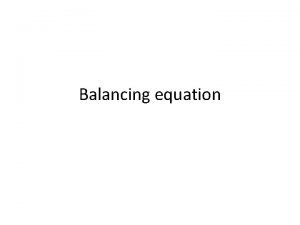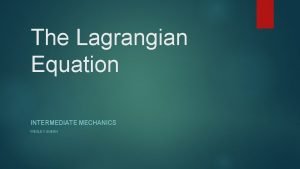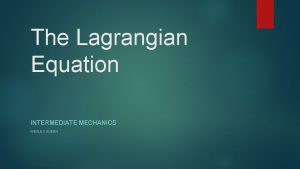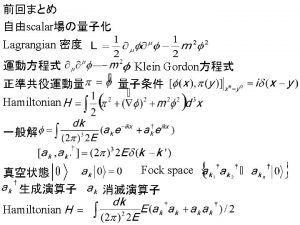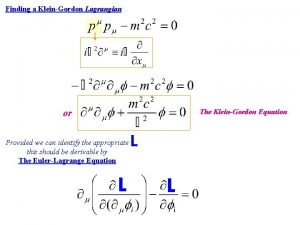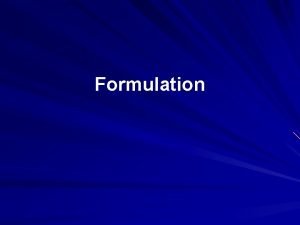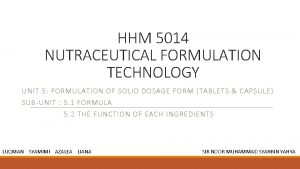Lagrangian formulation of the Klein Gordon equation Klein

























































- Slides: 57

Lagrangian formulation of the Klein Gordon equation Klein Gordon field Manifestly Lorentz invariant } } T V Classical path : Euler Lagrange equation Klein Gordon equation

New symmetries

New symmetries Is invariant under …an Abelian (U(1)) gauge symmetry

New symmetries Is not invariant under

New symmetries Is invariant under …an Abelian (U(1)) gauge symmetry

New symmetries Is invariant under …an Abelian (U(1)) gauge symmetry

New symmetries Is invariant under …an Abelian (U(1)) gauge symmetry A symmetry implies a conserved current and charge. e. g. Translation Rotation Momentum conservation Angular momentum conservation

New symmetries Is invariant under …an Abelian (U(1)) gauge symmetry A symmetry implies a conserved current and charge. e. g. Translation Rotation Momentum conservation Angular momentum conservation What conservation law does the U(1) invariance imply?

Noether current Is invariant under …an Abelian (U(1)) gauge symmetry

Noether current Is invariant under …an Abelian (U(1)) gauge symmetry

Noether current Is invariant under …an Abelian (U(1)) gauge symmetry

Noether current Is invariant under …an Abelian (U(1)) gauge symmetry

Noether current Is invariant under …an Abelian (U(1)) gauge symmetry 0 (Euler lagrange eqs. )

Noether current Is invariant under …an Abelian (U(1)) gauge symmetry 0 (Euler lagrange eqs. ) Noether current

The Klein Gordon current Is invariant under …an Abelian (U(1)) gauge symmetry

The Klein Gordon current Is invariant under …an Abelian (U(1)) gauge symmetry

The Klein Gordon current Is invariant under …an Abelian (U(1)) gauge symmetry This is of the form of the electromagnetic current we used for the KG field

The Klein Gordon current Is invariant under …an Abelian (U(1)) gauge symmetry This is of the form of the electromagnetic current we used for the KG field is the associated conserved charge

Suppose we have two fields with different U(1) charges : . . no cross terms possible (corresponding to charge conservation)

Additional terms

Additional terms } Renormalisable

Additional terms } Renormalisable

U(1) local gauge invariance and QED

U(1) local gauge invariance and QED

U(1) local gauge invariance and QED not invariant due to derivatives

U(1) local gauge invariance and QED not invariant due to derivatives To obtain invariant Lagrangian look for a modified derivative transforming covariantly

U(1) local gauge invariance and QED not invariant due to derivatives To obtain invariant Lagrangian look for a modified derivative transforming covariantly Need to introduce a new vector field

is invariant under local U(1)

is invariant under local U(1) Note : is equivalent to universal coupling of electromagnetism follows from local gauge invariance

is invariant under local U(1) Note : is equivalent to universal coupling of electromagnetism follows from local gauge invariance The Euler lagrange equation give the KG equation:

is invariant under local U(1) Note : is equivalent to universal coupling of electromagnetism follows from local gauge invariance

The electromagnetic Lagrangian

The electromagnetic Lagrangian

The electromagnetic Lagrangian

The electromagnetic Lagrangian

The electromagnetic Lagrangian Forbidden by gauge invariance

The electromagnetic Lagrangian Forbidden by gauge invariance The Euler-Lagrange equations give Maxwell equations !

The electromagnetic Lagrangian Forbidden by gauge invariance The Euler-Lagrange equations give Maxwell equations !

The electromagnetic Lagrangian Forbidden by gauge invariance The Euler-Lagrange equations give Maxwell equations ! EM dynamics follows from a local gauge symmetry!!

The photon propagator The propagators determined by terms quadratic in the fields, using the Euler Lagrange equations.

The Klein Gordon propagator (reminder) In momentum space: With normalisation convention used in Feynman rules = inverse of momentum space operator multiplied by -i

The photon propagator The propagators determined by terms quadratic in the fields, using the Euler Lagrange equations.

The photon propagator The propagators determined by terms quadratic in the fields, using the Euler Lagrange equations. Gauge ambiguity

The photon propagator The propagators determined by terms quadratic in the fields, using the Euler Lagrange equations. Gauge ambiguity

The photon propagator The propagators determined by terms quadratic in the fields, using the Euler Lagrange equations. Gauge ambiguity i. e. with suitable “gauge” choice of α (“ξ” gauge) want to solve

The photon propagator The propagators determined by terms quadratic in the fields, using the Euler Lagrange equations. Gauge ambiguity i. e. with suitable “gauge” choice of α (“ξ” gauge) want to solve In momentum space the photon propagator is (‘t Hooft Feynman gauge ξ=1)


Extension to non-Abelian symmetry

Extension to non-Abelian symmetry

Extension to non-Abelian symmetry where

Extension to non-Abelian symmetry where i. e. Need 3 gauge bosons

Weak Interactions Symmetry : SU(2) local gauge theory Local conservation of 2 weak isospin charges Weak coupling, α 2 u d Wa=1. . 3 Gauge boson (J=1) e Neutral currents A non-Abelian (SU(2)) local gauge field theory

Symmetry : Local conservation of 3 strong colour charges QCD : a non-Abelian (SU(3)) local gauge field theory

The strong interactions QCD Quantum Chromodynamics Symmetry : Local conservation of 3 strong colour charges SU(3) Strong coupling, α 3 q q Ga=1. . 8 Gauge boson (J=1) “Gluons” QCD : a non-Abelian (SU(3)) local gauge field theory

Partial Unification Matter Sector “chiral” Family Symmetry? Up Down Family Symmetry? Neutral

Partial Unification Matter Sector “chiral” } Family Symmetry? } Up Down Family Symmetry? Neutral

Partial Unification } Matter Sector “chiral” } } Family Symmetry? Up Down Family Symmetry? Neutral
 Klein gordon lagrangian
Klein gordon lagrangian Dirac equation ppt
Dirac equation ppt Klein gordon equation
Klein gordon equation Why problem formulation follow goal formulation
Why problem formulation follow goal formulation Lagrangian equation of motion
Lagrangian equation of motion Significato equazione di dirac
Significato equazione di dirac Lagrangiana
Lagrangiana Lagrangian optimization
Lagrangian optimization Lagrangian standard model
Lagrangian standard model Standard model
Standard model Lagrangian optimization
Lagrangian optimization Eulerian vs lagrangian
Eulerian vs lagrangian Lagrangian
Lagrangian Lagrangian relaxation tutorial
Lagrangian relaxation tutorial Define ignorable coordinates
Define ignorable coordinates Stranglet
Stranglet Quantum chromodynamics lagrangian
Quantum chromodynamics lagrangian Lagrangian
Lagrangian Hamiltonian dynamics
Hamiltonian dynamics Standard model
Standard model Incompressiblity
Incompressiblity Lagrange equation
Lagrange equation Lagrange equation
Lagrange equation Qcd lagrangian
Qcd lagrangian I j k x y z
I j k x y z Atwood machine lagrangian
Atwood machine lagrangian Klein bottle equation
Klein bottle equation Hát kết hợp bộ gõ cơ thể
Hát kết hợp bộ gõ cơ thể Ng-html
Ng-html Bổ thể
Bổ thể Tỉ lệ cơ thể trẻ em
Tỉ lệ cơ thể trẻ em Chó sói
Chó sói Tư thế worms-breton
Tư thế worms-breton Hát lên người ơi
Hát lên người ơi Các môn thể thao bắt đầu bằng tiếng nhảy
Các môn thể thao bắt đầu bằng tiếng nhảy Thế nào là hệ số cao nhất
Thế nào là hệ số cao nhất Các châu lục và đại dương trên thế giới
Các châu lục và đại dương trên thế giới Công thức tính độ biến thiên đông lượng
Công thức tính độ biến thiên đông lượng Trời xanh đây là của chúng ta thể thơ
Trời xanh đây là của chúng ta thể thơ Mật thư anh em như thể tay chân
Mật thư anh em như thể tay chân Phép trừ bù
Phép trừ bù Phản ứng thế ankan
Phản ứng thế ankan Các châu lục và đại dương trên thế giới
Các châu lục và đại dương trên thế giới Thơ thất ngôn tứ tuyệt đường luật
Thơ thất ngôn tứ tuyệt đường luật Quá trình desamine hóa có thể tạo ra
Quá trình desamine hóa có thể tạo ra Một số thể thơ truyền thống
Một số thể thơ truyền thống Cái miệng bé xinh thế chỉ nói điều hay thôi
Cái miệng bé xinh thế chỉ nói điều hay thôi Vẽ hình chiếu vuông góc của vật thể sau
Vẽ hình chiếu vuông góc của vật thể sau Biện pháp chống mỏi cơ
Biện pháp chống mỏi cơ đặc điểm cơ thể của người tối cổ
đặc điểm cơ thể của người tối cổ V. c c
V. c c Vẽ hình chiếu đứng bằng cạnh của vật thể
Vẽ hình chiếu đứng bằng cạnh của vật thể Fecboak
Fecboak Thẻ vin
Thẻ vin đại từ thay thế
đại từ thay thế điện thế nghỉ
điện thế nghỉ Tư thế ngồi viết
Tư thế ngồi viết Diễn thế sinh thái là
Diễn thế sinh thái là
